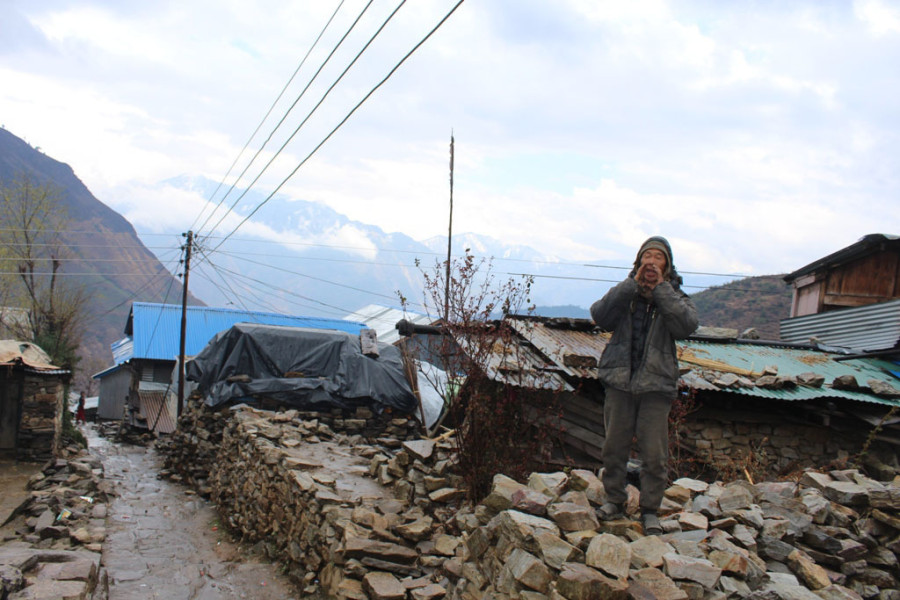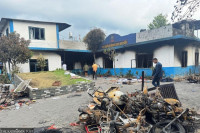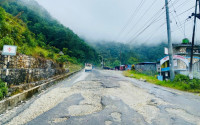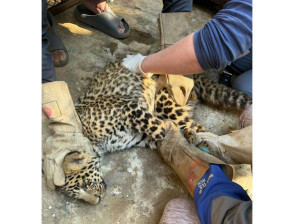Sixty-four-year-old Dambar Bahadur Gurung has been the herald of his village in Dharche Rural Municipality, Laprak for the past four years. Heralds are village ‘criers’, people who announce important notices in the villages. Dambar’s job currently is to shout out information about the coronavirus pandemic from atop Mani Hill in the village.
In the local lingo, a village crier is called a ‘Katuwal’, and Dambar was appointed as one because of his clear and loud voice. For the people in the villages of the rural municipality, such Katuwals are the only reliable medium of information.
With the country locked down over concerns of coronavirus, Katuwal Dambar is busy these days relaying messages about preventions to make and precautions to take to keep safe from the novel coronavirus.
“These days I pass information about the coronavirus,” said Dambar Bahadur. “Initially I asked people to wash their hands frequently and visit a health centre if they catch a fever or cold. These days I request villagers to stay inside the house and avoid mass gatherings,” he said.
Dambar says he does his rounds around villages in the rural municipality, shouting out messages for around two hours each in the morning and the evening every day. “People listen to me when I start to shout. I also go to the villages and teach people especially the elderly about sanitation,” he said.
Dambar was asked to disseminate information about the global pandemic by the ward office and health office since they figured that relaying messages through Katuwals would be effective in raising awareness among the villagers in the rural municipality with around 500 households.
Ward chairperson of Dharche ward number 4, Raj Gurung, said passing information through a Katuwal was more effective in villages than implementing door-to-door awareness campaigns in times like this. “Disseminating messages through Katuwals is a very old method of communicating. People here have more faith in the messages provided by Katuwals than those broadcast on radio and television,” he said.
Gurung said he asked Dambar to pass informative messages about the novel coronavirus after coordinating with the health office. “Initially he taught people about cleanliness and washing hands, and to identify the symptoms of the virus in people. Since the lockdown, he has been urging people to stay indoors and avoid non-essential outings,” said Gurung.
There are seven Katuwals in Dharche Rural Municipality who have been employed by the rural municipality in Uhiya, Lapu, Gumda, Kerauja and Kashigaun. With the slogan ‘One ward, one Katuwal’, the rural municipality also provides them with monthly allowances.
Frequently asked questions about the coronavirus outbreak
UPDATED as of September 22, 2020
What is Covid-19?
Covid-19, short for coronavirus disease, is an illness caused by the coronavirus SARS-CoV-2, short for severe acute respiratory syndrome coronavirus 2. Common symptoms of the disease include fever, dry cough, fatigue, shortness of breath and breathing difficulties. In severe cases, the infection can cause pneumonia, severe acute respiratory syndrome, kidney failure and even death.
How contagious is Covid-19?
Covid-19 can spread easily from person to person, especially in enclosed spaces. The virus can travel through the air in respiratory droplets produced when a sick person breathes, talks, coughs or sneezes. As the virus can also survive on plastic and steel surfaces for up to 72 hours and on cardboard for up to 24 hours, any contact with such surfaces can also spread the virus. Symptoms take between two to 14 days to appear, during which time the carrier is believed to be contagious.
Where did the virus come from?
The virus was first identified in Wuhan, China in late December. The coronavirus is a large family of viruses that is responsible for everything from the common cold to Middle East Respiratory Syndrome (MERS) and Severe Acute Respiratory Syndrome (SARS). After an initial outbreak in Wuhan that spread across Hubei province, eventually infecting over 80,000 and killing more than 3,000, new infection rates in mainland China have dropped. However, the disease has since spread across the world at an alarming rate.
What is the current status of Covid-19?
The World Health Organisation has called the ongoing outbreak a “pandemic” and urged countries across the world to take precautionary measures. Covid-19 has spread to 213 countries and territories around the world and infected more than 31,405,983 people with 967,505 deaths and 22,990,260 recoveries. In South Asia, India has reported the highest number of infections at 5,557,573 with 88,943 deaths. While Pakistan has reported 306,304 confirmed cases with 6,420 deaths. Nepal has so far reported 65,276 cases with 427 deaths.
How dangerous is the disease?
The mortality rate for Covid-19 is estimated to be 3.6 percent, but new studies have put the rate slightly higher at 5.7 percent. Although Covid-19 is not too dangerous to young healthy people, older individuals and those with immune-compromised systems are at greater risk of death. People with chronic medical conditions like heart disease, diabetes and lung disease, or those who’ve recently undergone serious medical procedures, are also at risk.
How do I keep myself safe?
The WHO advises that the most important thing you can do is wash your hands frequently with soap and water for at least 20 seconds or use hand sanitizers with at least 60 percent alcohol content. Avoid touching your eyes, nose and mouth with unclean hands. Clean and disinfect frequently used surfaces like your computers and phones. Avoid large crowds of people. Seek medical attention if symptoms persist for longer than a few days.
Is it time to panic?
No. The government has imposed a lockdown to limit the spread of the virus. There is no need to begin stockpiling food, cooking gas or hand sanitizers. However, it is always prudent to take sensible precautions like the ones identified above.





 8.12°C Kathmandu
8.12°C Kathmandu.jpg)











